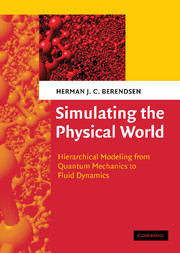Book contents
- Frontmatter
- Contents
- Preface
- Symbols, units and constants
- Part I A Modeling Hierarchy for Simulations
- 1 Introduction
- 2 Quantum mechanics: principles and relativistic effects
- 3 From quantum to classical mechanics: when and how
- 4 Quantum chemistry: solving the time-independent Schrödinger equation
- 5 Dynamics of mixed quantum/classical systems
- 6 Molecular dynamics
- 7 Free energy, entropy and potential of mean force
- 8 Stochastic dynamics: reducing degrees of freedom
- 9 Coarse graining from particles to fluid dynamics
- 10 Mesoscopic continuum dynamics
- 11 Dissipative particle dynamics
- Part II Physical and Theoretical Concepts
- References
- Index
7 - Free energy, entropy and potential of mean force
Published online by Cambridge University Press: 05 June 2012
- Frontmatter
- Contents
- Preface
- Symbols, units and constants
- Part I A Modeling Hierarchy for Simulations
- 1 Introduction
- 2 Quantum mechanics: principles and relativistic effects
- 3 From quantum to classical mechanics: when and how
- 4 Quantum chemistry: solving the time-independent Schrödinger equation
- 5 Dynamics of mixed quantum/classical systems
- 6 Molecular dynamics
- 7 Free energy, entropy and potential of mean force
- 8 Stochastic dynamics: reducing degrees of freedom
- 9 Coarse graining from particles to fluid dynamics
- 10 Mesoscopic continuum dynamics
- 11 Dissipative particle dynamics
- Part II Physical and Theoretical Concepts
- References
- Index
Summary
Introduction
As we know from the applications of thermodynamics, free energy is much more important than energy, since it determines phase equilibria, such as melting and boiling points and the pressure of saturated vapors, and chemical equilibria such as solubilities, binding or dissociation constants and conformational changes. Unfortunately, it is generally much more difficult to derive free energy differences from simulations than it is to derive energy differences. The reason for this is that free energy incorporates an entropic term –TS; entropy is given by an integral over phase space, while energy is an ensemble average. Only when the system is well localized in space (as a vibrating solid or a macromolecule with a well-defined average structure) is it possible to approximate the multidimensional integral for a direct determination of entropy. This case will be considered in Section 7.2.
Free energies of substates can be evaluated directly from completely equilibrated trajectories or ensembles that contain all accessible regions of configurational space. In practice it is hard to generate such complete ensembles when there are many low-lying states separated by barriers, but the ideal distribution may be approached by the replica exchange method (see Section 6.6). Once the configurational space has been subdivided into substates or conformations (possibly based on a cluster analysis of structures), the free energy of each substate is determined by the number of configurations observed in each substate.
Information
- Type
- Chapter
- Information
- Simulating the Physical WorldHierarchical Modeling from Quantum Mechanics to Fluid Dynamics, pp. 211 - 248Publisher: Cambridge University PressPrint publication year: 2007
Accessibility standard: Unknown
Why this information is here
This section outlines the accessibility features of this content - including support for screen readers, full keyboard navigation and high-contrast display options. This may not be relevant for you.Accessibility Information
- 1
- Cited by
